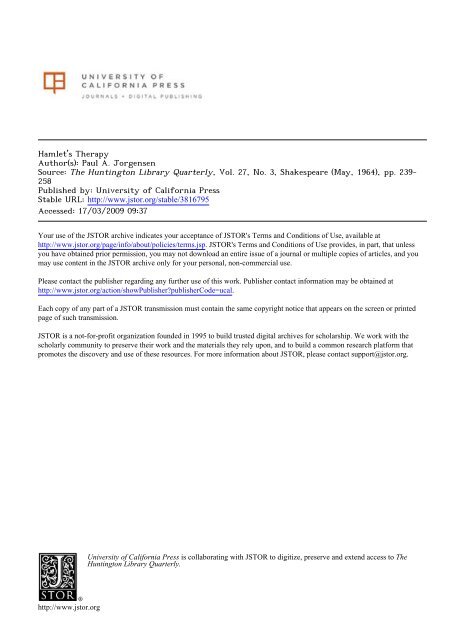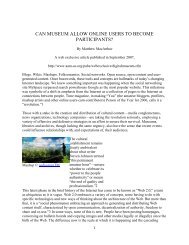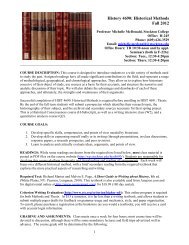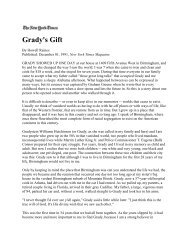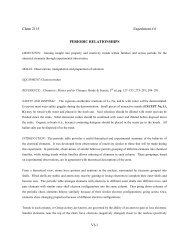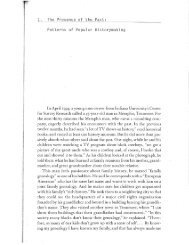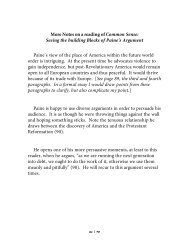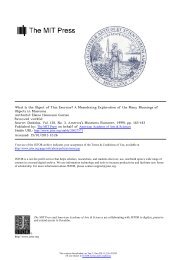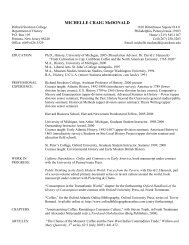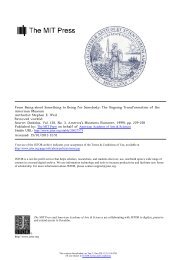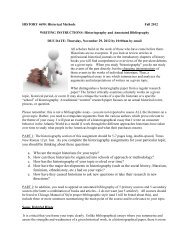Hamlet's Therapy Author(s): Paul A. Jorgensen Source: The ...
Hamlet's Therapy Author(s): Paul A. Jorgensen Source: The ...
Hamlet's Therapy Author(s): Paul A. Jorgensen Source: The ...
Create successful ePaper yourself
Turn your PDF publications into a flip-book with our unique Google optimized e-Paper software.
<strong>Hamlet's</strong> <strong><strong>The</strong>rapy</strong><br />
<strong>Author</strong>(s): <strong>Paul</strong> A. <strong>Jorgensen</strong><br />
<strong>Source</strong>: <strong>The</strong> Huntington Library Quarterly, Vol. 27, No. 3, Shakespeare (May, 1964), pp. 239-<br />
258<br />
Published by: University of California Press<br />
Stable URL: http://www.jstor.org/stable/3816795<br />
Accessed: 17/03/2009 09:37<br />
Your use of the JSTOR archive indicates your acceptance of JSTOR's Terms and Conditions of Use, available at<br />
http://www.jstor.org/page/info/about/policies/terms.jsp. JSTOR's Terms and Conditions of Use provides, in part, that unless<br />
you have obtained prior permission, you may not download an entire issue of a journal or multiple copies of articles, and you<br />
may use content in the JSTOR archive only for your personal, non-commercial use.<br />
Please contact the publisher regarding any further use of this work. Publisher contact information may be obtained at<br />
http://www.jstor.org/action/showPublisher?publisherCode=ucal.<br />
Each copy of any part of a JSTOR transmission must contain the same copyright notice that appears on the screen or printed<br />
page of such transmission.<br />
JSTOR is a not-for-profit organization founded in 1995 to build trusted digital archives for scholarship. We work with the<br />
scholarly community to preserve their work and the materials they rely upon, and to build a common research platform that<br />
promotes the discovery and use of these resources. For more information about JSTOR, please contact support@jstor.org.<br />
http://www.jstor.org<br />
University of California Press is collaborating with JSTOR to digitize, preserve and extend access to <strong>The</strong><br />
Huntington Library Quarterly.
<strong>Hamlet's</strong><br />
<strong><strong>The</strong>rapy</strong><br />
By PAUL A. JORGENSEN<br />
T IS THE purpose of this essay to call attention to an important,<br />
though doubtless secondary, objective of <strong>Hamlet's</strong> pilgrimage<br />
(like a Spenserian knight he can have more than one). This is the regaining<br />
of the sanity which he had formerly displayed as an ideal<br />
prince. Hamlet does recover; and his recovery is a part of the drama<br />
which grips us. Only thus can we fully account for the muchdiscussed<br />
"regeneration" of the hero in a play whose primary image<br />
is disease. And only thus can we realize the fullest meaning of his<br />
most impassioned speeches. We must view them as <strong>Hamlet's</strong> groping<br />
his way from an initial torpor and grief, through conscious anger, to<br />
a clear-sighted though troubled sanity. This groping serves as a prelude<br />
to his tragic wisdom and to his restoration as one who would<br />
have proved most royally had he been put on.<br />
Unlike other psychological students of the play, I am not primarily<br />
concerned with the almost hopeless task of precisely diagnosing<br />
<strong>Hamlet's</strong> malady, and I am glad to agree with most critics' that<br />
it is mainly pathological grief and its consequent disturbance, melancholia.<br />
My concern is a happier one, to show how he achieves what<br />
we would today call psychotherapy. My major evidence outside the<br />
play is from Renaissance treatises. Those dealing with remedies for<br />
grief and melancholia are usually, to Shakespeare's enormous credit,<br />
only partly relevant to Hamlet. <strong>The</strong> best of them, however, achieve<br />
an insight that is borne out by Freud and later students. I shall not<br />
hesitate, from too great allegiance to historical scholarship, to avail<br />
myself of a doctrine merely because it has not become outmoded.<br />
Freud's Oedipal view of Hamlet is unacceptable to most literary students;<br />
but one cannot so easily dispose of Freudian theories that are<br />
supported by the text of the play and by Renaissance psychology.<br />
What is certain is that Shakespeare achieved insights into psychotherapy<br />
which, though deriving from sixteenth-century theory, go<br />
centuries beyond the crude formulations of this theory. This he did<br />
1A good Renaissance diagnosis is made by Lily B. Campbell, Shakespeare's Tragic<br />
Heroes: Slaves of Passion (New York, 1952), Ch. xii. More modern diagnoses will be<br />
cited later.<br />
239
240<br />
HUNTINGTON LIBRARY QUARTERLY<br />
as a dramatist and not as a philosopher-psychologist, in which prosaic<br />
capacity he is firmly rooted in his own age.<br />
Today we are decreasingly interested in what was formerly the<br />
big question of the play: Was Hamlet mad? <strong>The</strong> opinion of most<br />
literary scholars and psychoanalysts is that Hamlet, as he tells us, is<br />
afflicted by "sore distraction' that he occasionally suffers hysteria<br />
and mania, but that as a tragic hero he becomes sane enough to be<br />
responsible for his actions. This does not, however, rule out the temporary<br />
presence of disabling grief and melancholia, the most poignant<br />
qualities in his early soliloquies. Concerning <strong>Hamlet's</strong> mental disturbance,<br />
A. C. Bradley writes:<br />
And if the pathologist calls his state melancholia, and even proceeds to<br />
determine its species, I see nothing to object to in that; I am grateful to<br />
him for emphasizing the fact that <strong>Hamlet's</strong> melancholy was no mere<br />
common depression of spirits; and I have no doubt that many readers of<br />
the play would understand it better if they read an account of melancholia<br />
in a work on mental diseases.2<br />
Bradley is right. If we turn to Freud's essay "Mourning and Melancholia"<br />
we find the following:<br />
<strong>The</strong> distinguishing mental features of melancholia are a profoundly painful<br />
dejection, cessation of interest in the outside world, loss of the capacity<br />
to love, inhibition of all activity, and a lowering of the selfregarding<br />
feelings to a degree that finds utterance in self-reproaches and<br />
self-revilings, and culminates in a delusional expectation of punishment.<br />
This picture becomes a little more intelligible when we consider that...<br />
the same traits are met with in mourning.3<br />
This is the Hamlet that we see at the beginning of the play and generally<br />
throughout the first three acts. But a change surely occurs, and<br />
many critics have noticed it. Bradley (p. 120) observes in the fifth<br />
act "a slight thinning of the dark cloud of melancholy." This, he<br />
thinks, may be part of a new sense of power after his dispatching of<br />
Rosencrantz and Guildenstern, but mainly it is a "kind of religious<br />
resignation:' According to 0. J. Campbell, Shakespeare "does not<br />
2Shakespearean Tragedy (New York, I960), p. 103. This, in general, is the opinion<br />
of scholars like J. Q. Adams, T. M. Parrott, and J. Dover Wilson.<br />
3In <strong>The</strong> Standard Edition of the Complete Psychological Works of Sigmund Freud,<br />
trans. and ed. James Strachey (London, I957), XIV, 244.
HAMLET'S THERAPY<br />
24I<br />
leave his audience with the view of Hamlet as a slave to a kind of<br />
mental malady. <strong>The</strong> fatal wound in the Prince's breast restores his<br />
equilibrium and produces a brief interval of serenity."4 Robert Ornstein<br />
also attributes the improvement mainly to a last-minute con-<br />
frontation of death, though he does see an improvement after the sea<br />
voyage.5 J. Q. Adams, who has made the only extensive psychological<br />
study of <strong>Hamlet's</strong> recovery, places the change in III.iv, with<br />
the appearance of the Ghost. According to Adams, the whole play<br />
breaks here:<br />
From this time on Hamlet is increasingly better. He begins to display<br />
more interest in life, he takes on a more hopeful attitude towards the<br />
world, his thinking loses much of its morbid quality, and his confidence<br />
in human nature is in part restored.... In the final scenes of the playas<br />
in the jesting with Osric, or in the friendly fencing contest with<br />
Laertes-his melancholia has almost disappeared.6<br />
Adams' estimate of the time of <strong>Hamlet's</strong> change is convincing, for<br />
the last scenes must show Hamlet acting rationally; insight delayed<br />
to the moment of death does not occur for even so slow a thinker as<br />
Othello. But Adams has no better reason for <strong>Hamlet's</strong> recovery than<br />
that melancholia passes normally through several stages, and recovery<br />
is, in time, inevitable. Time was indeed a Renaissance explanation<br />
for some cures,7 but it was hardly a dramatic or significant one.<br />
Shakespeare worked his hero's cure into the dramatic texture of the<br />
play.<br />
Because Renaissance psychotherapy has been inadequately studied,<br />
it may be useful to survey briefly some of the approaches. Perhaps<br />
the most favored for melancholia was a religious one. But Hamlet<br />
does not, because he is not really a guilty soul, fit the category written<br />
about by so many Elizabethan divines. <strong>Paul</strong> H. Kocher has ably<br />
differentiated between the psychologically (or physiologically) and<br />
the religiously caused melancholia.8 Hamlet, unlike Lady Macbeth<br />
4Hamlet, ed. O. J. Campbell et al. (New York, 1961), p. 7.<br />
5<strong>The</strong> Moral Vision of Jacobean Tragedy (Madison, I960), pp. 237-238.<br />
6Hamlet, ed. Joseph Quincy Adams (Boston, 1929), p. 288.<br />
7E.g., Nicolas Coeffeteau, A Table of Humane Passions, trans. E. Grimestone (Lon-<br />
don, 1621), p. 335.<br />
sScience and Religion in Elizabethan England (San Marino, I953). See particularly<br />
pp. 302-303; also his excellent article "Lady Macbeth and the Doctor:' Shakespeare<br />
Quarterly, V (I954), 341-349.
242<br />
HUNTINGTON LIBRARY QUARTERLY<br />
or Claudius with his "sick soul,' would not have been classified as suffering<br />
from an afflicted conscience, which often had symptoms similar<br />
to psychological melancholia.9<br />
When divines did offer guidance for psychological melancholia,<br />
they were not particularly helpful. When it is not manifestly de-<br />
rivative from psychological works, their advice (as exemplified by<br />
Thomas Adams, William Perkins, and Bishop Abernethy) is to mortify<br />
the passions. If the suffering is incurable, according to Perkins,<br />
"wee must humble our selves for our unquietnesse of minde.... It<br />
is Gods will that we should suffer affliction, and withall humble our<br />
selves under his mightie hand''l <strong>The</strong>re may be a hint of this attitude<br />
in the "religious resignation" which Hamlet has been presumed to<br />
suffer (or achieve) at the end of the play, partially in his acceptance<br />
of Heaven's will in the punishment which will follow his slaying of<br />
Polonius and more clearly in his "<strong>The</strong>re's a special providence in<br />
the fall of a sparrow"'1 But <strong>Hamlet's</strong> psychological recovery, while<br />
perhaps related to this, is something achieved through the mind and<br />
emotions rather than through the will. I shall, however, refer to the<br />
religious theme later in the essay.<br />
Moral philosophers were as busy as divines in offering advice and<br />
consolation. What is more, there is abundant evidence of their prescriptions<br />
in Hamlet; so much, in fact, that one might assume that<br />
they are held up as the ideal therapists. In a valuable article, "<strong>Hamlet's</strong><br />
Book"'2 Hardin Craig proposes that the volume which Hamlet<br />
enters reading (II.ii. 68), and which he presumably reads during<br />
his solitude, is a familiar book of consolation, a work by Girolamo<br />
Cardano translated as Cardanus Comforte (I576). Professor Craig is<br />
undoubtedly correct in writing that "belief in the therapeutic power<br />
of books was characteristic of Renaissance students. If a hero found<br />
himself stricken with grief, as Hamlet did, it was natural that he<br />
should resort to a work on consolation. Cardano wrote De consola-<br />
9For the difference between the two afflictions see William Perkins, <strong>The</strong> Estate of<br />
a Christian<br />
in This Life, in Works (Cambridge, 1605), p. 435.<br />
lOAn Exposition upon the Lords Prayer, in Works, p. 406. See also M. I. Abernethy<br />
(Bishop of Caithness), A Christian and Heavenly Treatise (London, I622), esp. pp.<br />
359-360.<br />
lIII.iv.173-175; Vii.23o. All Shakespeare references are to <strong>The</strong> Complete Plays and<br />
Poems of William Shakespeare, ed. W A. Neilson and C. J. Hill (Boston, I942).<br />
l2Huntington Library Bulletin, No. 6 (I934), pp. 17-37.
HAMLET'S THERAPY<br />
tione to comfort himself and all those stricken with grief" (p. 18).<br />
Craig stresses the resultant universalizing of <strong>Hamlet's</strong> plight if we<br />
view him as benefiting from this moving book, for Cardano makes it<br />
clear that most of humanity is involved in the struggle against grief,<br />
fear, and weakness. Like other moral philosophers, Cardano stresses<br />
reasonableness and, above all, fortitude, which is principally what<br />
the grieving Hamlet has to learn.<br />
Cardano is in the tradition of Plutarch, Cicero, Seneca, Boethius,<br />
and Thomas More. <strong>The</strong>se writers have perhaps too little sympathy<br />
with human weakness or with strong, uncontrolled passions. Cardano<br />
is typical of them in writing, in a passage that seems to bear<br />
suggestively on Hamlet:<br />
As therefore to cowards and men of no virtue, the timely death of the<br />
father hath ever brought hinderaunce: So to noble mindes: it be occasion<br />
whereby to shew themselves as they be. Thys must also be set before our<br />
eyes, that both lyfe and death be the gyftes of God, and do evermor depende<br />
upon his providence. <strong>The</strong>refore whosoever reproveth lyfe or<br />
Death, doeth in sylence disalowe & complayne of the devine Judgement,<br />
because both the one and the other is meete and profitable. (fol. 45V)<br />
A similarly stern note is heard in: "A follye I do think to comforte<br />
those that through debility of mynde do cast themselves into misery:<br />
as foule delight, and desperate revenges" (fol. IOT). Nevertheless<br />
even Cardano recognizes the occasional inadequacy of stern reason<br />
in dealing with grief: "for oftentimes, thoughe reason comforte us,<br />
and teache us that neither mourninge, is mete, neither that there is<br />
any cause of mourning, yet the sadde mynde of it selfe can not bee<br />
merye" (fol. 15). He must have known this from personal experience-a<br />
circumstance which lifts the Comforte above most books of<br />
consolation. Philippe de Mornay, another very wise and sensitive<br />
commentator on human misery, states what perhaps Hamlet and<br />
other students felt about the utility of the moral philosophers in dealing<br />
with mental suffering: "<strong>The</strong>y pacify not the debates a man feeles<br />
in himselfe, they cure not the diseases of his minde'13<br />
Hamlet may envy Horatio his Stoic self-sufficiency, his moderation,<br />
his ability to suffer all yet suffer nothing. He may read endlessly<br />
in the books (or book) of the philosophers. But so doing does<br />
13A Discourse of Life and Death, trans. Mary, countess of Pembroke (London,<br />
I592), Sig. [C4]v.<br />
243
HUNTINGTON LIBRARY QUARTERLY<br />
not greatly help him. Much of the advice of Cardano and the other<br />
moral therapists is reproduced in the play, but it is not given the best<br />
of spokesmen. It is put into the mouths of Claudius and Gertrude.<br />
In the second scene, Hamlet is told that the death of fathers is common<br />
and natural, that to mourn excessively shows a will most incorrect<br />
to Heaven, a mind impatient. His attitude toward such reasoning<br />
is that "'tis common,' probably implying that it is too much a matter<br />
of commonplace books and not enough a matter of dearly purchased<br />
experience. It is Claudius who triumphantly lays claim to successful<br />
conquest of grief, and through the 244<br />
very precepts of the "common"<br />
moral treatises:<br />
Though yet of Hamlet our dear brother's death<br />
<strong>The</strong> memory be green, and that it us befitted<br />
To bear our hearts in grief, and our whole kingdom<br />
To be contracted in one brow of woe,<br />
Yet so far hath discretion fought with nature<br />
That we with wisest sorrow think on him<br />
Together with remembrance of ourselves.<br />
(I.ii.i-7)<br />
Hamlet cannot so easily dispel grief and melancholia. Nor do I think<br />
Shakespeare felt it a culpable flaw in him to fail in so doing. With<br />
Brabantio in Othello, Hamlet might say: "But words are words; I<br />
never yet did hear / That the bruis'd heart was pierced through the<br />
ear" (I.iii.2I8-2I9); or with the grieving Leonato in Much Ado<br />
about Nothing:<br />
I will be flesh and blood;<br />
For there was never yet philosopher<br />
That could endure the toothache patiently.<br />
(Vi.34-36)<br />
Perhaps what is fundamentally wrong with the comfort books<br />
and the books of stern exhortation is that they talk at the patient.<br />
Shakespeare seems to have felt the hollowness of their encouragement<br />
and the futility of their comfort. We know from later experiences<br />
in treating melancholia that more dynamic methods, deriving<br />
from the patient's experiencing of emotion, are needed. <strong>The</strong>se, moreover,<br />
would be ideally suited to drama.
HAMLET'S THERAPY<br />
245<br />
Besides divines and moral philosophers, the Renaissance had many<br />
psychological writers, some of whom were also divines and some<br />
strictly physicians. But men like Timothy Bright, Andre du Laurens,<br />
Thomas Wright, Nicolas Coeffeteau, and Robert Burton, regardless<br />
of their area of learning, usually divide their therapy between the<br />
body and the mind. <strong><strong>The</strong>rapy</strong> through the body was surely the least<br />
brilliant achievement of Renaissance psychology. Shakespeare ignores<br />
it in Hamlet (though he does not do so in King Lear). If <strong>Hamlet's</strong><br />
disease had been humoral, then bloodletting, baths, and a very<br />
complicated diet would have been indicated.14 Significantly, none of<br />
those trying to cure Hamlet once suggest such procedures. Hence,<br />
most of the predominantly medical treatises are of no relevance.<br />
<strong>Hamlet's</strong> relatives and supposed friends attempt to cure him by<br />
other strategies, most of them endorsed by the psychologists; and<br />
Shakespeare provides for his hero, in Horatio, one of the most commonly<br />
approved remedies for melancholia: a faithful friend.15 <strong>The</strong><br />
friend should serve as someone to whom the sufferer can express his<br />
griefs and confide his secrets and in whom he can see the wholesomeness<br />
of sanity; a melancholy friend is dangerous. In all respects<br />
Horatio is exemplary. Hamlet sees in him a model of sanity, and<br />
Horatio is also an extraordinarily good listener. His "Ay, my lord"<br />
is his most characteristic utterance. But we do not very often witness<br />
Hamlet confiding any important emotions to Horatio. His most<br />
heartfelt unhappinesses are expressed in soliloquy. However, we<br />
should notice the degree to which Hamlet brightens up when he first<br />
sees Horatio, and even his exhilaration when he meets the two false<br />
friends, Rosencrantz and Guildenstern.<br />
<strong>The</strong> latter two, incidentally, seem to be provided by the King not<br />
only as a means of sounding out Hamlet but as a possible way to cure<br />
the youth whose antics cause him and the court so much annoyance.<br />
<strong>The</strong>y come to Hamlet as therapeutic friends. Rosencrantz explains<br />
to the Prince the psychological usefulness which doubtless Claudius<br />
sees in <strong>Hamlet's</strong> two schoolfellows: "You do surely bar the door<br />
of your own liberty if you deny your griefs to your friend" (III.ii.35<br />
1-353). Guildenstern, upon receiving his charge from the King,<br />
14For the strictly physical remedies for melancholia, see Philip Barrough, <strong>The</strong><br />
Method of Phisick (London, 1596), pp. 47-48.<br />
s5E.g., Thomas Wright, <strong>The</strong> Passions of the Minde (London, 1604), p. 78.
246<br />
HUNTINGTON LIBRARY QUARTERLY<br />
exclaims: "Heavens make our presence and our practices / Pleasant<br />
and helpful to him!" (II.ii.38-39). And Claudius himself clarifies<br />
(at least ostensibly) his motives to both schoolmates:<br />
so by your companies<br />
To draw him on to pleasure, and to gather<br />
So much as from occasions you may glean,<br />
Whether aught, to us unknown, afflicts him thus,<br />
That, open'd, lies within our remedy.<br />
(II.ii. 14-18)<br />
For Claudius is one of the principal characters in the play trying<br />
to cure Hamlet. One of his most eager remarks occurs when Polonius<br />
makes his promising, but mistaken, diagnosis: love melancholy.<br />
Claudius, hearing of a likely solution, exclaims, "0, speak of that;<br />
that do I long to hear" (II.ii.5o). <strong>Hamlet's</strong> therapy, not his death,<br />
has been Claudius' attempt from the beginning, and remains so probably<br />
until Claudius becomes aware of <strong>Hamlet's</strong> murderous intent.<br />
We have seen that the King's first words to Hamlet are aimed at correcting<br />
the Prince's stubborn grief. Claudius, in fact, follows in this<br />
scene the traditional prescription for a therapist given by Robert<br />
Burton:<br />
By all means, therefore, fair promises, good words, gentle persuasions<br />
are to be used, not to be too rigorous at first, or to insult over them, not<br />
to deride, neglect, or contemn, but rather, as Lemnius exhorteth, to<br />
pity, and by all plausible means to seek to reduce them: but if satisfaction<br />
may not be had, mild courses, promises, comfortable speeches, and<br />
good counsel, will not take place; then, as Christopherus a Vega determines,<br />
to handle them more roughly, to threaten and chide....16<br />
Thus Claudius turns from "comfortable speeches" to a rougher<br />
handling during this scene. He is at first the kindly, fatherly coun-<br />
selor; then the severe uncle-father. Whether or not Claudius is sincerely<br />
seeking <strong>Hamlet's</strong> recovery, others would have viewed his solicitous<br />
and expert ministrations in this light.<br />
<strong>The</strong> "precept" technique having failed, Claudius listens eagerly,<br />
but skeptically, to Polonius' diagnosis, and then endorses another<br />
psychological remedy for melancholia: diversion, particularly in the<br />
l6<strong>The</strong> Anatomy of Melancholy, ed. Floyd Dell and <strong>Paul</strong> Jordan-Smith (New York,<br />
1941), pp. 476-477.
HAMLET'S THERAPY<br />
form of a play.17 This proves to be an even more disastrous failure.<br />
After the murder of Polonius, Claudius proposes on his own another<br />
of the perennial remedies, this one being sea travel:<br />
Haply the seas and countries different<br />
With variable objects shall expel<br />
This something-settled matter in his heart,<br />
Whereon his brains still beating puts him thus<br />
From fashion of himself.<br />
(III.i.179-183)<br />
Psychologists were divided about the efficacy of this therapy, since<br />
it did not really alter the patient's view of himself or others.l8 It is<br />
very unlikely that the sea voyage makes Hamlet psychologically<br />
well. <strong>The</strong> improvement is noticeable before he leaves Denmark. But<br />
the voyage promised to be useful to Claudius, while still preserving<br />
his reputation as a kindly therapist.<br />
<strong>The</strong> Queen is to prove, in a way she does not guess, to be instrumental<br />
in <strong>Hamlet's</strong> recovery. But in her own shallow way, she too<br />
has been trying from the outset to cure her son. Her first diagnosis<br />
is a simple and fairly sound one: "I doubt it is no other but the main, /<br />
His father's death and our o'erhasty marriage" (II.ii.56-57). But<br />
upon hearing Polonius' diagnosis, she changes, perhaps without much<br />
conviction, to a new hope:<br />
And for your part, Ophelia, I do wish<br />
That your good beauties be the happy cause<br />
Of <strong>Hamlet's</strong> wildness. So shall I hope your virtues<br />
Will bring him to his wonted way again,<br />
To both your honours.<br />
(III.i.3 8-42)<br />
It was believed, by du Laurens among others, that a victim of love<br />
247<br />
melancholy could be improved by the possession of the love object.19<br />
But Hamlet promptly relieves both Claudius and Gertrude of any<br />
hope on this score.<br />
17Recommended by Burton, p. 482; Coeffeteau, pp. 343-345.<br />
18Justus Lipsius speaks against travel on the grounds that it is superficial. See Two<br />
Bookes of Constancie, trans. Sir John Stradling, ed. Rudolf Kirk (New Brunswick,<br />
I939), P. 75.<br />
19Andr6 du Laurens, A Discourse of the Preservation of the Sight (London, I599),<br />
p. I2I. Burton, p. 798, calls this the "last refuge and surest remedy'
HUNTINGTON LIBRARY QUARTERLY<br />
<strong>The</strong> play becomes more considerably a study in psychotherapy if<br />
we recognize that most of the principal characters-Claudius, Gertrude,<br />
Polonius, and Rosencrantz and Guildenstern-are engaged in<br />
the frustrating business of trying to diagnose and cure <strong>Hamlet's</strong> malady.<br />
But he is not a pipe for all fingers to play upon. <strong>The</strong> source of<br />
his grief, like the grief itself, passes show. Above all, he illustrates<br />
what seems to have been Shakespeare's attitude to psychotherapy<br />
from without. One of the most poignant and lasting questions in<br />
Shakespeare is Macbeth's "Canst thou not minister to a mind diseas'd<br />
... ?" (Viv.4o). And the doctor's answer points the way toward<br />
what truly occurs in Hamlet: "<strong>The</strong>rein the patient / Must<br />
minister to himself.' Hamlet recovers as a tragic hero and not merely<br />
as a mental patient. He achieves a new wisdom and self-knowledge;<br />
and this, I believe, is through the very modern, but also Renaissance,<br />
process of bringing to awareness his deepest feelings.<br />
What is it in <strong>Hamlet's</strong> extremely complex nature that must come<br />
to the surface of consciousness? Many readers have noticed with<br />
dismay a ferocious quality in the gentle, meditative Prince. His treatment<br />
of Ophelia, if we are inclined to an ideal picture, approaches<br />
motiveless cruelty.20 Bradley came close to the truth when he observed<br />
<strong>Hamlet's</strong> "almost savage irritability" (pp. 105-Io6). This<br />
anger is not, obviously, the fact about himself that Hamlet most<br />
clearly recognizes in the first part of the play. It 248<br />
is, however, not unnoticed<br />
by <strong>Hamlet's</strong> keenest and most interested observer, Claudius.<br />
Near the midpoint of the play, the King perceives what I think the<br />
Renaissance would have recognized as the underlying source of<br />
<strong>Hamlet's</strong> melancholia. He calls it a "danger"' but he is referring to<br />
the latent, grimly angry quality in Hamlet:<br />
<strong>The</strong>re's something in his soul<br />
O'er which his melancholy sits on brood,<br />
And I do doubt the hatch and the disclose<br />
Will be some danger....<br />
(III.i. I72-I75)<br />
It is "the hatch and the disclose" of <strong>Hamlet's</strong> anger which gives<br />
mounting drama to the play even as it gives the sick Prince health.<br />
20Dover Wilson remarks: "<strong>The</strong> attitude of Hamlet towards Ophelia is without<br />
doubt the greatest of all the puzzles in the play... .' What Happens in Hamlet (New<br />
York, 1935), p. ioi.
HAMLET'S THERAPY<br />
It is fully recognized by Hamlet himself late in the play when he<br />
warns Laertes:<br />
Sir, though I am not splenitive and rash,<br />
Yet have I something in me dangerous,<br />
Which let thy wiseness fear.<br />
(Vi.284-286)<br />
249<br />
Melancholia is today recognized as often due to repressed rage.<br />
<strong>The</strong> anger, instead of being turned outward, is turned upon oneself,<br />
with resultant dejection, apathy, and self-reviling. This is the message<br />
of Dr. Karl Menninger's Man against Himself (I938). It was<br />
also so interpreted by Freud: "<strong>The</strong> self-tormenting in melancholia<br />
. .. signifies, just like the corresponding phenomenon in the obsessional<br />
neurosis, a satisfaction of trends of sadism and hate which relate<br />
to an object, and which have been turned round upon the subject's<br />
own self" (p. 251).<br />
Objections to a Freudian interpretation of Shakespeare are often<br />
made on the grounds that it is anachronistic. We have here, however,<br />
a Freudian interpretation that was almost a Renaissance commonplace,<br />
with the one exception that Renaissance psychology did<br />
not construct a systematic theory based upon the unconscious. <strong>The</strong><br />
system came much later, but the theory itself was both expounded<br />
by psychologists and depended upon for the correct interpretation<br />
of literary character.<br />
<strong>The</strong> Renaissance recognized the inevitable relationship of pas-<br />
sions, as it did of complexions. Joy may, as Miss Campbell has pointed<br />
out (p. I ), be the emotion commonly linked with grief. Such a<br />
connection was, however, one of the most obvious and least sophisti-<br />
cated observations made by Renaissance psychology. It was a far<br />
more brilliant observation to see that grief (with its resultant sorrow<br />
or melancholia) was inseparably linked with anger. Writing of path-<br />
ological sorrow, Jean Fran9ois Senault states:<br />
Choler is of the same condition; though she make so much noise, she<br />
draws all her force from the Passions which compose her; and she appears<br />
not to be couragious, save only that she is well accompanied; she is never<br />
raised in our souls uncalled by Sorrow; she endeavors not satisfaction for<br />
injuries done unto her, unless sollicited by Desire, provoked by Hope,<br />
and encouraged by Audacity; for he that is irritated, promiseth himself
250<br />
HUNTINGTON LIBRARY QUARTERLY<br />
revenge of his enemy; but when he is so weak, as he cannot hope for it,<br />
his Choler turns to Sadnesse ...21<br />
<strong>The</strong> theory of the unconscious is here, but imperfect; for the false<br />
assumption is made that only fear of reprisal keeps one from venting<br />
anger and thus avoiding sorrow. A similar linking of choler and grief<br />
occurs in an earlier work, Coeffeteau's A Table of Humane Passions:<br />
" we must remember that Choler is also full of griefe and bitternesse,<br />
for that it propounds the injury received, the which shee cannot<br />
easily disgest .. ' (p. 559). And it occurs in Burton: "Anger, a per-<br />
turbation, which carries the spirits outwards, preparing the body to<br />
melancholy, and madness itself" (p. 233). <strong>The</strong> connection between<br />
the two emotions goes back, however, not only to Shakespeare's<br />
time (e.g., Timothy Bright) but even to the classical period. In<br />
fact, one of the sources in which Shakespeare was most likely to<br />
have read of suppressed anger turning into sorrow or grief is Plu-<br />
tarch's life of Coriolanus. Martius alone, Plutarch writes, showed no<br />
outward anger at his banishment.<br />
Not that he did patiently bear and temper his good hap, in respect of any<br />
reason he had, or by his quiet condition: but because he was so carried<br />
away with the vehemency of anger, and desire of revenge, that he had no<br />
sense nor feeling of the hard estate he was in, which the common people<br />
judge not to be sorrow, although it is the very same. For when sorrow<br />
(as you would say) is set afire, then it is converted into spite or<br />
malice.... 22<br />
<strong>The</strong> important adjunct of suppressed anger turning into grief is<br />
that, as Freud has noticed, the individual punishes himself. This<br />
tendency of grief to be self-punishing was noticed by Coeffeteau in<br />
162 , though with inadequate emphasis upon the role of anger:<br />
"the soule helpes to afflict herselfe, whether that melancholy workes<br />
this effect, or that the continuall afflictions oppresse her in such sort,<br />
as she doth nothing but sigh under the burthen of sorrow .. .' (p.<br />
327). Shakespeare seems to have recognized more clearly than did<br />
psychologists the necessity for a choice between punishing oneself<br />
and punishing the real (external) source of grief. Hamlet affords the<br />
21<strong>The</strong> Use of Passions, trans. Henry, earl of Monmouth (London, 1671), pp. 404-<br />
405. An earlier edition of this translation appeared in 1649.<br />
22Shakespeare's Plutarch, ed. C. E Tucker Brooke (London, 1909), II, I74.
HAMLET'S THERAPY<br />
most sustained dramatic evidence of his awareness, but in other<br />
works the message is made more explicitly.<br />
In Much Ado about Nothing Antonio tries to comfort his<br />
brother, Leonato, not only by hortatory words (as we have already<br />
noticed) but by more dynamic psychological advice. He warns him<br />
of the danger and foolishness of self-recrimination:<br />
If you go on thus, you will kill yourself;<br />
And 'tis not wisdom thus to second grief<br />
Against yourself.<br />
(V.i.I-3)<br />
And he offers the sensible therapeutic advice: "Yet bend not all the<br />
harm upon yourself; / Make those that do offend you suffer too<br />
(Vi.39-40).<br />
A more sustained example of Shakespeare's depiction of paralytic<br />
grief slowly exposing the anger beneath occurs in <strong>The</strong> Rape of<br />
Lucrece. When Collatinus learns of the rape of his wife, he first exemplifies,<br />
as though in a speaking picture, the spectacle of one's grief<br />
raging, mutely, against oneself. Collatinus struggles, with at first only<br />
partial success, "to blow / <strong>The</strong> grief away that stops his answer so":<br />
Lo, here, the hopeless merchant of this loss,<br />
With head declin'd, and voice damm'd up with woe,<br />
With sad set eyes, and wretched arms across,<br />
From lips new waxen pale begins to blow<br />
<strong>The</strong> grief away that stops his answer so:<br />
But, wretched as he is, he strives in vain;<br />
What he breathes out his breath drinks up again.<br />
As through an arch the violent roaring tide<br />
Outruns the eye that doth behold his haste,<br />
Yet in the eddy boundeth in his pride<br />
Back to the strait that forc'd him on so fast;<br />
In rage sent out, recall'd in rage, being past:<br />
Even so his sighs, his sorrows, make a saw,<br />
To push grief on and back the same grief draw.<br />
(11. 1660-73)<br />
This is a fairly close approximation to the grief-stricken Hamlet of<br />
the first soliloquy, turning most of his anger upon himself. <strong>The</strong>se<br />
two stanzas reveal that catatonic grief is far from a passionless state.<br />
25I
252<br />
HUNTINGTON LIBRARY QUARTERLY<br />
<strong>The</strong>n, in Lucrece, Brutus makes perfectly explicit, in advising his<br />
friend, that the anger should be turned outward:<br />
Why, Collatine, is woe the cure for woe?<br />
Do wounds help wounds, or grief help grievous deeds?<br />
Is it revenge to give thyself a blow<br />
For his foul act by whom thy fair wife bleeds?<br />
Such childish humour from weak minds proceeds;<br />
Thy wretched wife mistook the matter so,<br />
To slay herself, that should have slain her foe.<br />
(11. I821-27)<br />
Shakespeare was not alone among creative writers in recognizing<br />
this harsh truth. A comparable episode occurs in Sidney's Arcadia.<br />
Amphialus, reacting to grief first with "a deepe sigh... seemed even<br />
to condemn him selfe, as though indeed his reproches were true. But<br />
howsoever the dulnes of Melancholy would have languishingly<br />
yeelded thereunto, his Courage (unused to such injuries) desired<br />
help of Anger... .'2<br />
<strong>The</strong> obvious therapy for melancholia, then, is to convert grief to<br />
its real, but disguised, source: anger.24 <strong>The</strong> psychologist Timothy<br />
Bright cautiously prescribes this remedy, though only after first recommending<br />
that the patient try reason, divinity, and avoidance of<br />
disturbances (Bright became a divine after a career in medicine):<br />
And if no other perswasion will serve a vehement passion, of another sort<br />
is to be kindled, that may withdrawe that vain and foolish sorowe into<br />
some other extremity, as of anger ... For although they both breed a<br />
dislike, yet that proceedeth of other cause, rebateth the force of it which<br />
first gave occasion, and as one pinne is driven out with another, so the<br />
later may expell the former....25<br />
This is, except for the caution, the advice of Malcolm to the<br />
stunned Macduff. Like Hamlet, Macduff is first stricken by his own<br />
unworthiness rather than anger toward Macbeth. He refers to him-<br />
23<strong>The</strong> Countesse of Pembrokes Arcadia, ed. Albert Feuillerat (Cambridge, Eng.,<br />
I939), p. 454.<br />
24This is suggested, but without application to Hamlet, by Ruth Leila Anderson in<br />
her pioneering study, Elizabethan Psychology and Shakespeare's Plays (Iowa City,<br />
1927), p. 91. Laertes is effectively cited by Miss Campbell (p. i'5) as a youth who<br />
successfully converts his grief to anger.<br />
25A Treatise of Melancholy (London, 1586),pp. 255-256.
HAMLET'S THERAPY<br />
253<br />
self as "sinful Macduff" (IViii.224). Malcolm tries to persuade the<br />
thane to break out of his torpor and express his real grievance-first<br />
of all merely to "give sorrow words:' <strong>The</strong>n Malcolm speaks the lines<br />
that represent the outstanding insight of Renaissance psychotherapy:<br />
"Be this the whetstone of your sword; let grief / Convert to anger;<br />
blunt not the heart, enrage it" (IViii.228-229). Changing from the<br />
blunted to the enraged heart, and converting grief to anger-these<br />
represent the progress of Hamlet from self-reviling muteness to the<br />
consciously and accurately enraged Hamlet of the last scenes. To recount<br />
this progress would be to tell the play; I can here point only<br />
to a few crucial speeches and episodes.<br />
When we first see Hamlet, he is almost catatonic in his melancholia.<br />
We learn from him that he sighs and weeps (recommended,<br />
yet superficial, ways of relieving grief), but he speaks almost not at<br />
all to other people. His hostility to his parents is expressed only<br />
obliquely, sometimes in asides and in ironic and punning comments.26<br />
Irony is of course a disciplined, intellectual rather than emotional,<br />
form of expressing anger. It does not ease the heart; and Hamlet later<br />
in the second scene, at the end of his first soliloquy, seems to apprehend<br />
an important fact about his grief: "It is not, nor it cannot come<br />
to good.- / But break my heart, for I must hold my tongue" (I.ii.<br />
I58-I59). <strong>The</strong> body of the soliloquy does outwardly direct some<br />
anger-toward his mother's behavior-but it is spoken only to himself.<br />
In speaking to his mother, he is coldly courteous. <strong>The</strong> tone of<br />
the soliloquy and its principal direction point to self-punishment. It<br />
is not his mother whom he wishes to destroy but himself:<br />
O, that this too too solid flesh would melt,<br />
Thaw, and resolve itself into a dew!<br />
Or that the Everlasting had not fix'd<br />
His canon 'gainst self-slaughter!<br />
(I.ii.I29- 32)<br />
In <strong>Hamlet's</strong> second soliloquy (II.ii.575-634) the anger is much<br />
more evident. In fact, the soliloquy is his most ranting one. He is beginning<br />
to feel, though not to express to others, the fullness of his<br />
anger: "Bloody, bawdy villain! / Remorseless, treacherous, lecher-<br />
26Later he is to resort to the "antic disposition' which permits him freedom to insult<br />
others. I suspect that the need for expressing anger, and not hysteria or caginess, is<br />
the real reason for the antic disposition.
254<br />
HUNTINGTON LIBRARY QUARTERLY<br />
ous, kindless villain!" Significantly, however, almost all of the abusive<br />
language of the speech is still directed against himself. He is "a<br />
rogue and peasant slave' "a dull and muddy-mettled rascal"' "an<br />
ass'' But he is much more alive than he was in the dull grief of the<br />
first soliloquy. He may be angry mainly with himself, but he is at<br />
least consciously trying to whip himself into a perception of the<br />
emotion that underlies his melancholia. Anger, though misdirected,<br />
has come very much to the surface.<br />
In <strong>Hamlet's</strong> progress from grief to anger, the "To be, or not to<br />
be" soliloquy (III.i.56-88) is crucial. After it is spoken, Hamlet<br />
seems capable of venting his anger upon Ophelia, though only indirectly<br />
upon Claudius (who overhears the veiled threats but is not,<br />
strictly speaking, addressed as an enemy). <strong>The</strong> soliloquy is usually<br />
interpreted as a contemplation of suicide. It is certainly, but not totally,<br />
that. Hamlet is still more grieved than angered, more intent<br />
upon punishing himself than upon punishing others. But we should<br />
observe that the second line of the speech turns to a subject somewhat<br />
different from the more famous first line:<br />
Whether 'tis nobler in the mind to suffer<br />
<strong>The</strong> slings and arrows of outrageous fortune,<br />
Or to take arms against a sea of troubles,<br />
And by opposing end them.<br />
"Suffer" or "bear' as opposed to "take arms" becomes the key word<br />
of the rest of the soliloquy. Indeed, the speech is thoroughly meaningful<br />
only if we take it to express <strong>Hamlet's</strong> growing awareness that<br />
his one hope (Heaven is not yet seen as "ordinant") is to change<br />
from passiveness to angry activity. It is a debate, not simply whether<br />
to be or not to be, but whether to "bear" or to do. "For who would<br />
bear the whips and scorns of time . .. ?" "Who would fardels<br />
bear .. . ?" Only fear of the future "makes us rather bear those ills<br />
we have"' Significantly, much of the grievance is directed outward:<br />
against the oppressor, the proud man, unrequited love, the law, the<br />
insolence of office, and the suffering of the patient man. From this<br />
point onward Hamlet is much less patient. His "danger" is becoming<br />
overt. Within a few lines he is lashing against Ophelia and women,<br />
and we thereby are becoming aware, as is Hamlet himself, of where<br />
his true hostility lies.
HAMLET'S THERAPY 255<br />
<strong>The</strong> anger is against his mother, though it is first misdirected<br />
against Ophelia and all women. By the end of III.ii, Hamlet is no<br />
longer a victim of melancholia, precisely because he has turned the<br />
frightening force of his hatred upon the one person who has most<br />
cruelly betrayed him and his father. Here, incidentally, one must<br />
radically depart from the Oedipal theory. To assume that the Prince<br />
resents his father, one must disregard not only Renaissance psychology<br />
but the most emotional passages of the play. Perhaps for this<br />
reason the psychoanalytical critics, including Ernest Jones (the best<br />
of them), are indifferent to <strong>Hamlet's</strong> recovery from mental distress.<br />
One can account for this recovery only through the content of the<br />
emotional speeches and their change of hostile direction from Hamlet<br />
to his mother. <strong>The</strong> elder Hamlet never, even after <strong>Hamlet's</strong> hostility<br />
has come to full consciousness, is spoken of unlovingly.<br />
"Now could I drink hot blood" (III.ii.4o8). In this passionate<br />
declaration Hamlet is still speaking only to himself, but there is no<br />
doubt of the completeness with which he has transferred his loathing<br />
from himself to his mother. He could now, if it were not for being<br />
unnatural, become like Nero. When we next see him with his<br />
mother, in the great closet scene (III.iv), he speaks no longer to himself<br />
but to her. <strong>The</strong> scene is dramatically, perhaps, the most successful<br />
in the play. Except for the soliloquies, it contains <strong>Hamlet's</strong> most<br />
heartfelt lines. In fact, it is the only scene in the play in which Hamlet<br />
talking to others is as impressive as Hamlet talking to himself. It<br />
is this, I believe, because it is essentially dealing with the same theme<br />
as the soliloquies: <strong>Hamlet's</strong> anger. But it is less subtle and interesting<br />
than the soliloquies because the anger is not so painfully disguised.<br />
Even here, however, Hamlet must-for the last time-struggle<br />
against his impulse to suppress his true feelings. <strong>The</strong> struggle is now<br />
a brief one and occurs only because the Ghost appears and warns<br />
him to comfort his mother. <strong>The</strong> Ghost, who (very much like the<br />
early Hamlet) has "a countenance more in sorrow than in anger"'<br />
does not share <strong>Hamlet's</strong> murderous hatred of his mother; indeed, it<br />
is partially the Ghost's command that has kept Hamlet from more<br />
promptly converting his grief to anger. <strong>The</strong> Ghost now looks at<br />
Hamlet in a way almost to redirect his emotion to tears rather than<br />
anger:
256<br />
HUNTINGTON LIBRARY QUARTERLY<br />
Do not look upon me,<br />
Lest with this piteous action you convert<br />
My stern effects; then what I have to do<br />
Will want true colour, tears perchance for blood.<br />
(III.iv.2 7-130)<br />
<strong>The</strong> hesitancy, however, does not last. Hamlet does not kill his<br />
mother, but he speaks to her with "words like daggers" and with<br />
brutal, sexually specific candor. By the end of IViv, there is no ques-<br />
tion as to his commitment: "0, from this time forth, / My thoughts<br />
be bloody, or be nothing worth" (IViv.65-66).<br />
<strong>The</strong> importance to Hamlet of the closet scene has been recognized<br />
by John E. Hankins, who calls the scourging of Gertrude almost a<br />
"conversion" for the Prince:<br />
Nowhere after this scene does Hamlet show the same bitterness that he<br />
had earlier expressed. Even in his subsequent resolve to kill the King, he<br />
seems animated by a desire for justice rather than by vengeful hatred....<br />
<strong>The</strong> emotional catharsis of his experience has given him a certain serenity<br />
of spirit which he has not felt at any earlier time in the play.27<br />
But Hamlet does not (occasion does not permit it) entirely lose<br />
his anger; and one may well ask what effect such an emotion would<br />
have upon a final Renaissance estimate of the hero. Although anger<br />
was a dangerous passion, it had its defenders, particularly those who<br />
recognized that there was no such state as a lack of passion, and that<br />
if a cause for anger existed, it was hazardous and foolish to suppress<br />
the emotion. Pierre Charron writes, typically, of the danger of<br />
"smothering" choler:<br />
<strong>The</strong>re are some that smother their choler within, to the end it breake<br />
not forth, and that they may seeme wise and moderate; but they fret<br />
themselves inwardly, and offer themselves a greater violence than the<br />
matter is worth. It is better to chide a little, and to vent the fire, to the end<br />
it be not ever-ardent and painfull within.... All diseases that appeare<br />
openly are the lighter, and then are most dangerous when they rest hidden<br />
with a counterfet health.28<br />
27<strong>The</strong> Character of Hamlet and Other Essays (Chapel Hill, 1941), pp. 51-52.<br />
28Of Wisdome, trans. S. Lennard (London, 1625), p. 564. Moreover, the irascible<br />
power was generally considered to be more desirable than the concupiscible (includ-<br />
ing grief). See Coeffeteau, pp. 28-29.
HAMLET'S THERAPY<br />
<strong>The</strong> quotation is an apposite one, for the central image in the play is<br />
the opening of a hidden disease. Montaigne speaks to much the same<br />
effect, and with his refreshing and prophetic good sense:<br />
I would rather perswade a man, though somewhat out of season, to give<br />
his boy a wherret on the eare, then to dissemble this wise, sterne or severe<br />
countenance, to vex and fret his minde. And I would rather make show<br />
of my passions, then smother them to my cost: which being vented and<br />
exprest, become more languishing and weake: Better it is to let its pointe<br />
worke outwardly, then bend it against our selves.29<br />
<strong>The</strong>re may also be present in Hamlet an endorsement of what<br />
Hiram Haydn has called the "ireful virtues" as opposed to the Stoic<br />
virtues in the movement which he proposes under the name of the<br />
Counter-Renaissance.30<br />
Certainly in all of Shakespeare's four major<br />
tragedies there are extended, and usually persuasive, passages de-<br />
fending an aggressive rather than passive confronting of grief. In<br />
King Lear, which alone we have not considered, the King spends<br />
much effort in deciding between patience (involving grief and tears)<br />
and wrathful revenge. It does not matter to the rightness of his con-<br />
clusion that he is actually unable to take revenge:<br />
You see me here, you gods, a poor old man,<br />
As full of grief as age; wretched in both!<br />
If it be you that stirs these daughters' hearts<br />
Against their father, fool me not so much<br />
To bear it tamely; touch me with noble anger,<br />
And let not women's weapons, water-drops,<br />
Stain my man's cheeks!<br />
(II.iv.275-28 )<br />
257<br />
Shakespeare, unlike the moral Spenser of Book II of <strong>The</strong> Faerie<br />
Queene, did not decisively condemn noble anger.31<br />
Are we, after all, to assume that the intolerable suffering of a<br />
tragic hero is better than the display of anger? Is anger against one-<br />
self really better than anger against others? If we so conclude, we<br />
29"0f Anger and Choler' <strong>The</strong> Essayes of Montaigne, trans. John Florio (New York,<br />
[1933]), p. 645.<br />
30<strong>The</strong> Counter-Renaissance (New York, 1950). For Hamlet see pp. 619-636.<br />
31Anger is of course not the solution to Lear's mental suffering. He is not a melancholiac.<br />
<strong>The</strong> Alcibiades episode in Timon of Athens (III.v) also vindicates anger as<br />
opposed to "bearing!'
HUNTINGTON LIBRARY QUARTERLY<br />
must condemn Hamlet and his final, healthy self in a world worthy<br />
of anger. Hamlet in the last scene is angry, furiously angry. <strong>The</strong><br />
good nature and fairness he has shown to Laertes and the King is<br />
mightily abused, and he reacts with anger no longer toward himself<br />
but toward the aggressors.<br />
He does, however, show intermittently what Hankins rightly<br />
calls "a certain serenity of spirit:' And because the religious motif is<br />
so strong in the final scene, one hesitates to ascribe his serenity primarily<br />
to psychological recovery. Critics have written at length<br />
about the "regeneration" of Hamlet, and by this they mean his spiritual,<br />
not his psychological, well-being.32 Perhaps the two are not so<br />
disparate as we make them today, notably in literary criticism. Perhaps<br />
the only kind of religious acceptance that counts dramatically<br />
is that achieved with a clear mind. A Hamlet destroyed during the<br />
depths of his melancholia would scarcely be a tragic hero. We should<br />
also not forget that only the last scene shows a religiously serene<br />
Hamlet. His psychological recovery has occurred safely before this<br />
time.<br />
But I do not wish to arouse the anger of the religious critics (many<br />
of whom would do well to sample the efforts of Elizabethan divines<br />
to treat melancholia). All that I seek to achieve in this essay is a renewed<br />
respect for the psychological view of Hamlet, without in<br />
any way minimizing the importance of a religious view, here and in<br />
much great tragedy.33 <strong>The</strong> psychological view, particularly if the<br />
sufferer achieves new insight, can lead to emotions comparable to<br />
those claimed by the religious view. Man can, after all, win his tragic<br />
way to wisdom not merely through resignation to God's will, but<br />
also through self-knowledge, through understanding his own hidden<br />
thoughts and feelings. Hamlet, at once the most religious and most<br />
intelligent of 258<br />
Shakespeare's heroes, does both.<br />
32<strong>The</strong> strongest interpretation is that of J. A. Bryant, Jr., Hippolyta's View. Some<br />
Christian Aspects of Shakespeare's Plays (Lexington, I960), Ch. viii. See also the<br />
stimulating, but more moderate, criticism by Irving Ribner, Patterns in Shakespearian<br />
Tragedy (New York, 196o), Ch. iv; also <strong>Paul</strong> N. Siegel, Shakespearean Tragedy and the<br />
Elizabethan Compromise (New York, 1957), Ch. vii. <strong>The</strong> earlier scholarship on the<br />
subject is helpfully analyzed by S. E Johnson, "<strong>The</strong> Regeneration of Hamlet: Shakespeare<br />
Quarterly, III (1952), I87-207.<br />
33I try to bring the two together in my article "Hamlet and the Restless Renaissance,'<br />
Shakespearean Essays (Knoxville, Tenn., I964). <strong>The</strong>rein, in fact, I argue that a goodly<br />
part of <strong>Hamlet's</strong> self-deprecation has a religious (as well as psychological) basis.


